 |
|
|||
 |
 |
|||
Copyright © Harry Rinker, LLC 2017 Questions
and Answers
QUESTION: I have a hard copy with dust jacket of the 1957 edition of Dr. Seuss “The Cat in the Hat.” The dust jacket is in okay condition. Prices on eBay range from $10.00 to $5,000.00. Can you direct me to some actual sale results? – KT, Madisonville, KY, Email Question 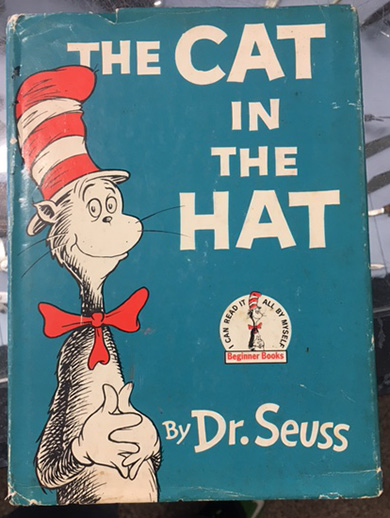
ANSWER: As Dr. Seuss might have written: “Start at the Beginning.” The question that must be answered before discussing value is to determine whether you have a first, second, or third printing of the first edition. This impacts value. The website http://1stedition.net/beginnerbooks/bbback01.html provides helpful information. First, examine the dust jacket. When first published, “The Cat in the Hat” sold for $2.00. “200/200” is found on the top of the right front flap. “FOR BEGINNING READERS” enclosed in a circle is located beneath “HAT.” The dust jacket does not have “Printed in the U.S.A.” on the back flap. This dust jacket was used from March 1957 until early 1958. The second dust jacket with no price on the flap was published between late 1957 and early 1958. It was during this period that Ted Geisel (Dr. Seuss) founded Beginning Books and issued four other titles. The final price point was not set until after the second dust jacket was printed. The third dust jacket printing was issued in early 1958 through mid-year 1958. It has “195/195” on the flap. In the fall of 1958, the back cover designed was change to reflect the release of five additional books in the Beginner Book series. If the dust jacket is missing, there are methods to determine an early printing. The first printing had a matte finish cover. Subsequent printings had a glossy cover. The first printing had a single bound signature. The second and later printings had three bound signatures. Open the book and look at the top of the spine. The three signatures sewn together are easy to spot. The copyright page which reads: Educational Edition published by Houghton Mifflin Company, Cost / Trade edition published simultaneously in New York by Random House, Inc. and In Toronto, Canada, by Random House of Canada, Limited” offers another clue. The educational edition, released in advance of the trade edition in January 1957, has a cover with a white background. The trade edition, released in March 1957, has a cover with a blue background. 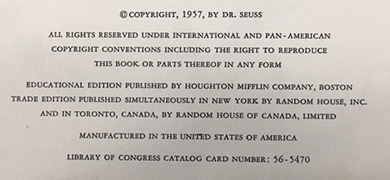
WorthPoint.com is the internet’s equivalent of a comprehensive price guide to antiques and collectibles. It is a subscription service. WorthPoint.com only lists items that have sold. It does not record “Buy It Now” offers that did not close or estimates for auction lots that did not sell. QUESTION: We inherited grandmother’s old table lamp. It needs a total restoration. Before we invest the money, we want to know the potential worth of the lamp after restoration. The lamp has a metal base, standard, and frame structure that hold eight triangular pieces of shaped frosted glass with floral paintings on the reverse. There are no markings on the lamp or shade. Any information that you can provide will be greatly appreciated – R&PE, Toronto, OH, Email Question 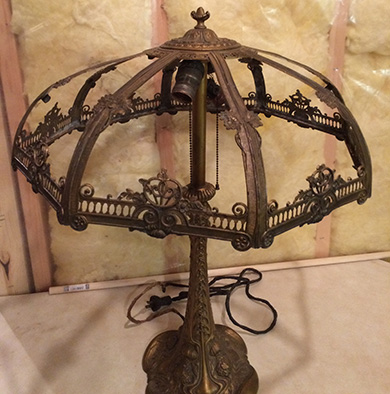
ANSWER: The generic term for your lamp is a slag or custard slag lamp. Having stated this, your eight, reverse painted, bent glass panels are not slag glass. Once a manufacturer produced the frame, it was free to choose a wide variety of glass panel inserts to put into the frame. After examining the pictures which accompanied your email, I am not certain the lamp needs a full restoration. The standard and frame appear to be in good shape with little to no break or wear problems. When considering restoration, more is less is the rule. Since the glass panels already are removed from the shade frame, start by examining the wiring and light sockets. Replacing either has little impact on the lamp’s value. Several of the major Big Box home supply stores offer a cord that closely resembles old cord. Avoid reusing an older socket plug. Replace the plug with a modern example. Resist the temptation to spray paint or alter the coloring on the standard, frame, and top. Instead, consider using a mild detergent, such as Woolite, and carefully clearing the lamp. Do a small section at a time. Clean, rise, and dry. Use a Q-tip to clean grooved areas. If you are satisfied, as I suspect you will be, stop. Do not expect the piece to look as though it just came off the assembly line. The goal is not a like-new appearance but a usable one. Do not be afraid to preserve aging quality. Give the glass panels a light dusting. Use a fine, soft bristle paint brush on the reverse painted surface. If the top surface is dirty, use the Woolite solution. 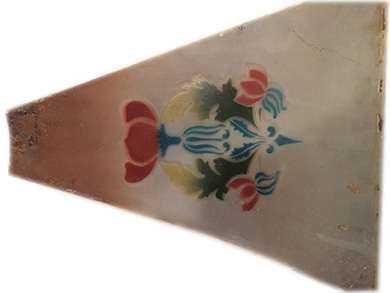
The key to a do it yourself approach is the condition of the tabs that hold the glass panels in place on the shade. If the tabs are still viable, move forward. If not, you need to find someone to replace them. This is a tricky procedure. The shade frame is made of a white/slush metal. It melts easily, meaning a standard home soldering iron is not acceptable. The cost of restoration often exceeds the final value of an object is an antiques and collectibles axiom. I have lost count of the number of times I have spent more to conserve, an approach I prefer over restoration, an object than the resulting value once the conservation was complete. I never regretted the money I spent, believing I left the campsite (in this case, the object) in better shape than I found it. Antiques and collectibles restorers are not licensed nor trained is a truism. Some are excellent, having spent decades honing their skills. Others are butchers, ruining objects rather than saving them. Before trusting your lamp to anyone, check their qualifications. Insist on seeing some of their finished work. Ask for references. The secondary market value for your lamp, cleaned up and with the light fixture and cord updated is between $500.00 and $600.00. The cost to have a skilled professional do the work, could easily exceed this number. QUESTION: I have a ceramic figural parrot liquor bottle that probably dates from the 1940s. It stands 12 1/2 inches high. The label reads: “P. GARNIER, Enghien (indistinct) & FILS PARIS.” It held apricot brandy. The bottom has what appears to be “K “with a “C” superimposed over it and the number “897.” Please tell me its value. – GS, Westfield, New Jersey, Email Question 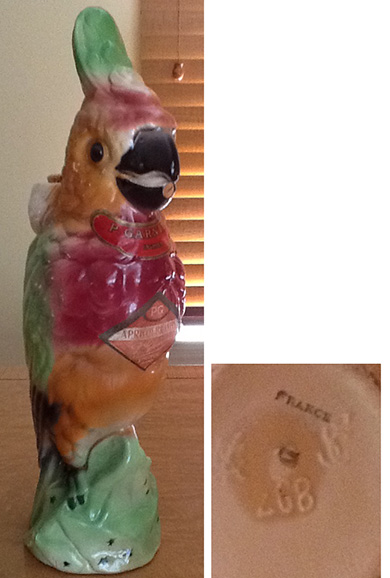
ANSWER: In order to find detailed information about your decanter, I had to search under cockatoo and parrot. P. Garnier, located in Enghien, France, exported liquors. In 1859, Paul Garnier (1832-1886) founded a Paris company to produced fruit and plant liquors. After the Franco-Prussian War, he moved his manufacturing plant to Enghien-Le Bains, home of apricot and cherry orchards. Julius Wine and Bros. became the company’s sole U.S. agent in 1877, renewing the agreement in 1964. [See: www.passionforthepastantiques.com /store/products/item/backPID /Products/categories/english/products/p-garnier-enghien-france-brandy-pitcher-c1934-38/?tt_products%5Bbegin_at%5D=570& cHash=df9b462e5b96d5fcd00642f9ab7d6abe]. I was unable to determine when P. Garnier ceased operations but suspect it was in the mid- to late 1980s. The company did sell figural liquor decanters during the “limited/collector edition whiskey bottle craze” of the late 1970s and 1980s. The mark on your decanter indicated it was made by St. Clement, a French pottery firm located in Barbontine. The company ceased operations around 1930. The high-gloss glaze is a majolica type. An internet seller dates the bottle from the 1920s, citing a reference on page 42 of Maryse Bottero’s “Pichets en Barbotine,” published by Charles Massin in October 2000. The dealer is asking $495.00. WorthPoint.com is a reality check, in this case providing a list of sell through versus asking prices. Examples sold on eBay in February 2017 for $30.00, in October 2015 for $24.97, in June 2013 for $50.00, in January 2013 for $112.40, and $64.99 in December 2011. What does this mean in respect to the value for your example with the labels still present? Think $35.00 to $40.00. Consider approaching the dealer asking $495.00 and offering to sell the bottle you own to him for $150.00. My best guess on his response is: “Sorry. Not interested.” QUESTION: I have a Castle Films 8mm film of a Woody Woodpecker cartoon entitled “Hollywood Matador.” The 3” x 3” box contains a colorful image of Woody. This belonged to my father who passed away in 1959. There is no date on the box, so I have no idea how old it is. Please tell me about this if you can. – SK, Email Question 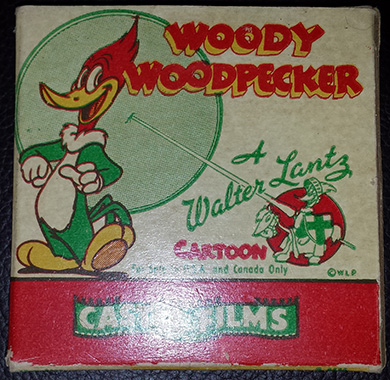
ANSWER: “The Hollywood Matador,” the fourth Woody Woodpecker animated cartoon short, was released on February 9, 1942. Eugene W. Castle founded Castle Films in 1924. The company branched out into 8mm and 16mm home movies in 1927. Castle began acquiring licensing rights to animated cartoons, adding Walter Lantz productions to his stable in 1947. Your home 8mm film dates from the late 1940s or early 1950s. Assuming the film is not brittle and/or cracked, a common problem, it has a secondary market value between $10.00 and $12.00. Harry L. Rinker welcomes questions from readers about
collectibles, those mass-produced items from the twentieth and twenty-first centuries.
Selected letters will be answered in this column.
Harry cannot provide personal answers.
Photos and other material submitted cannot be
returned.
Send your questions to: Rinker on Collectibles, 5955 Mill
Point Court SE, Kentwood, MI 49512.
You also can e-mail your questions to
harrylrinker@aol.com.
Only e-mails containing a full name and mailing address
will be considered.
You can listen
and participate in
WHATCHA GOT?, Harry’s
antiques and collectibles radio call-in show, on Sunday mornings between 8:00 AM
and 10:00 AM Eastern Time.
If you
cannot find it on a station in your area,
WHATCHA GOT?
streams live on the Internet at www.gcnlive.com.
SELL, KEEP OR TOSS?: HOW TO DOWNSIZE A HOME,
SETTLE AN ESTATE, AND APPRAISE PERSONAL PROPERTY
(House of Collectibles, an imprint of Random House Information Group, $17.99),
Harry’s latest book, is available at your favorite bookstore and via
www.harryrinker.com.
|
||||